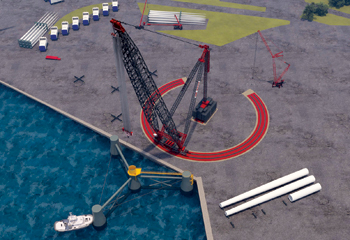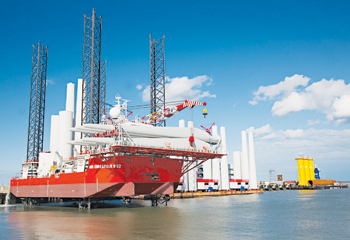

The crane has a maximum hook height prepared for 20 MW turbines and a capability to lift 6,000 tonnes, making the SK6,000 the largest and strongest land-based crane in the market
Mammoet, a heavy lifting and transport specialist, is investing in the next generation electric crane for next generation wind farms.
The SK6,000 is an evolution in the SK series of super heavy lift cranes and will serve the needs of both fixed-bottom and floating offshore wind.
As developers look to supply more cost-effective energy to consumers, offshore wind farms are moving to deeper waters and reaching higher to find stronger flows. As a result, the scale of turbine and foundation components – in both fixed and floating offshore wind – continues to grow.
Bottom fixed jackets and monopiles weighing between 2,000 tonnes and 3,000 tonnes are now common, while next generation turbine towers between 15 MW and 20 MW will rise beyond 150 m. If global installed capacity targets are to be realised, the supply chain must also grow.
For fixed-bottom projects, when loading-out 3,000-tonne jacket foundations in areas of high tidal range where RORO transfer is not always possible, or installing complete towers and nacelles of 20 MW turbines, the SK6,000 creates maximum value onshore prior to installation at sea.
The crane has a maximum hook height prepared for 20 MW turbines and a capability to lift 6,000 tonnes, making the SK6,000 the largest and strongest land-based crane in the market.
For floating wind projects, due to its a maximum radius of 144 m, the SK6,000 can lift a heavy floating foundation directly into the water and assemble its turbine from a single position. This turns the quayside into a highly efficient production line.
The flexibility and scalability of the SK design enables Mammoet to grow in real-time with the changing needs of its customers, thereby futureproofing developments and advancements in the segment.
As it is containerised, the SK6,000 can be mobilised to any port, allowing projects to be executed where the right knowledge and skills are abundant, and where high-value assets can be best utilised.
With hub heights continuing to grow, the SK6,000 offers a truly commercial-scale, carbon-free solution, delivering factory efficiency with next generation capacity.
And by using Mammoet’s electric-powered SPMT, the entire heavy lift and transport scope can be completed, fully emissions-free - at any location, worldwide.
The ring crane has been scheduled to begin production of its long lead time components starting Q3 2022. It will allow offshore wind projects to take place under entirely electric power, even where there is no connection available to the grid.
OFFSHORE WIND INNOVATION
Last month, at the Mammoet-sponsored 5th offshore wind innovation challenge, solutions were sought for the safe and efficient load transfer between two floating vessels, and methods to reduce the cost of turbine maintenance.
In front of a packed audience at Mammoet’s Conbit operation in Eindhoven, The Netherlands, the two finalists presented their concepts, before a team of prestigious judges from offshore wind innovators, Mammoet, Conbit, Shell, and Siemens Gamesa. In turn, SkyLifter and Seaqualize addressed the crowd.
The Seaqualize Delta turns any standard heavy lifting crane into a high-performance active heave-compensated crane, up to a significant wave height. This allows operations such as floating transition piece installations, feeder barge lifts of delicate components such as turbine nacelles, and even transfers from feeder barge to floating heavy lift vessel to take place more reliably.
So much so, that during feeder barge operations it can offer over 80 per cent higher workability during winter months, vastly extending the envelopes during which work can take place, and so keeping expensive specialist vessels busy.
Rated for 600 tonnes, its full passive load control ensures smooth motion with no accidental lift-offs or re-hits, resulting in a more productive and safer workplace.
SkyLifter is a solar electric air crane that can vertically lift payloads beyond the technical limits of the largest helicopters. Comprising a lenticular aerostat and an underslung pod, it is a lighter than air vessel that can remain in a geo-stationary position with minimal energy expenditure.
As it floats, SkyLifter naturally removes height barriers currently in place for turbine maintenance, due to the maximum height of available crane vessels. Capable of lifting up to 250 tonnes, it can perform maintenance of nacelle components and even blades, over a 2,000 km range.
Following a period of deliberation by the judges, Seaqualize was unveiled as the winner, and now has the chance to collaborate with Mammoet to further develop the solution.



































































